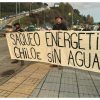Saturday, May 4, 2024
News and Views from the Global South
CUBA: Sugar Industry Restructuring Good for Environment
Patricia Grogg
- The restructuring of Cuba’s sugar industry, which began two years ago and has involved the closing of half of this Caribbean island nation’s sugar mills and the transfer of a large number of workers to other parts of the economy, will be good for the environment, say experts.
One of the biggest environmental problems involved in producing sugar, which was the engine of the local economy for centuries and is still one of the country’s leading foreign exchange-earners, is the dumping of large quantities of liquid waste into rivers and the sea.
The waste also seeps into the underground aquifers.
The 157 sugar mills that were operating here in the mid-1970s dumped an estimated 36 cubic metres of liquid waste a year.
”Since then, an understanding of the importance of fixing that problem has grown,” Esperanza Valdés, director of the National Centre for Environmental Management of the sugar industry, commented to IPS.
The National Centre’s mission is to orient and promote technological innovations for protection of the environment and the sustainable development of the sugar industry in Cuba.
The National Centre’s focus has been on the development of increasingly efficient technologies for the treatment of liquid waste produced by the industry, and on the perfection of existing techniques.
But Valdés clarified that the sugar industry waste is not toxic, although in order to break down in the environment, it uses large amounts of oxygen, causing damage to rivers.
”When dumped into a receptacle with sufficient oxygen to assimilate the organic material, the waste breaks down completely, without any problem,” she said.
But Cuba’s rivers do not carry much water, and the volume of waste dumped by the mills is often greater than the volume of the river water, which ends up causing severe damage to fauna and flora.
”If fish die, it is due to a lack of oxygen, which has been consumed by the sugar mill waste,” said Valdés.
”Protecting the environment has always been a priority” for the Sugar Ministry, she said.
However, Santiago Rodríguez with the University of Havana Centre of Studies on the Cuban Economy said the restructuring effort that got underway in 2002 has led to a modification of the sugar industry’s environmental strategies, and to a greater emphasis on the environment.
The restructuring has left 71 sugar mills still operating – less than half of the number that existed when the plan was launched – which produce no more than four million tons a year of sugar. The industry is also made up of 25 agro-industrial complexes, 13 distilleries, and 11 factories of torula or fodder yeast (Candida utilis) plants.
As part of the restructuring process, 62 percent of the land under the jurisdiction of the Sugar Ministry is now being used for forestry plantations and the cultivation of fresh produce. The remaining 38 percent continues to be dedicated to sugar cane plantations.
A large number of sugar cane industry workers have been reassigned to new jobs in agriculture, while several dozen have gone through training courses to prepare them for work in other areas of the economy.
Government officials say the main objective of the restructuring plan has been to increase revenues by means of ”an in-depth cost-cutting process,” which requires improved agricultural yields and industrial productivity.
Although sugar production in Cuba remains a guarantee for international loans, the industry is no longer the country’s main source of foreign exchange, having been overcome by tourism and family remittances sent home by Cubans abroad.
In his article on ”The Restructuring of the Sugar Industry and the Environment in Cuba”, Rodríguez points out that four million tons of sugar, the ceiling set for production, generate 1,260 tons of cachaza (sugarcane filter-cake), 439,000 tons of boiler ash, and 10,080 tons of bagasse or waste cane stalks.
A yield of four million tons also makes it possible to generate more than 2.5 million tons of compost – organic fertiliser made up of sugarcane filter-cake, bagasse, and boiler ash, which improves soil fertility and helps fight erosion.
Sugarcane filter-cake, a waste product generated by the process of the clarification of cane juice, contains organic materials and nutrients like nitrogen, phosphorus, calcium and potassium.
Between 2000 and 2003, the Sugar Ministry’s environmental preservation efforts mainly focused on more efficient use of water, the production of compost, and implementing the technique of drip-irrigation with fertiliser, also known as ”ferti-irrigation”.
Over the past five years, the sugar mills, distilleries and torula yeast plants have reduced their consumption of water from 1.69 to 0.72 cubic metres per ton of crushed cane, saving 34.9 million cubic metres of water.
Ferti-irrigation consists of the direct application of fertiliser through the irrigation system, using sugar mill liquid waste, distillery effluent, and vinasse, a byproduct of the alcohol distillation process.
”Direct irrigation is better, because when the liquid waste is treated, the content of organic material is reduced, and the balance between organic material and nitrogen and phosphorus is thrown off,” said Valdés.
Ferti-irrigation boosts sugar cane yields and expands the useful life of the plants from two to three years, while saving between 70 and 90 dollars per hectare a year in chemical and mineral fertilisers.
In his study, Rodríguez notes that in the 2002-2003 harvest, the technique helped save nearly 400,000 dollars in fertilisers, and reduced the amount of pollutants dumped by 23,000 tons.
Late last year, construction was completed on an industrial-scale plant that generates biogas from distillery effluent and the waste from a nearby sugar mill, in the central province of Villa Clara, some 300 kms from Havana.
Valdés said some 300 families would benefit from the energy potential of the biogas produced in the plant, part of which will also fuel the distillery boiler.
According to her calculations, the biogas obtained from the waste generated by a distillery with a capacity to produce around 500 hectolitres of alcohol a day can replace 30 to 40 percent of the fuel oil consumed by the distillery.

 Print
Print



